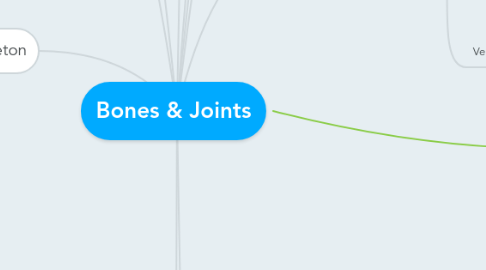
1. Appendicular Skeleton
1.1. Pectoral Girdles
1.1.1. Clavicle
1.1.2. Scapula
1.2. Upper Limbs
1.2.1. Humrus
1.2.2. Radius
1.2.3. Ulna
1.2.4. Carpal Bones
1.2.5. Metacarpal Bones
1.2.6. Phalanges
1.3. Pelvic Girdle
1.3.1. Hip Bones
1.4. Lower Limbs
1.4.1. Femur
1.4.2. Patella
1.4.3. Tibia
1.4.4. Fibula
1.4.5. Tarsal Bones
1.4.6. Metatarsal Bones
1.4.7. Phalanges
2. Bone Classification
2.1. Shape
2.1.1. Sutural Bones
2.1.2. Irregular Bones
2.1.3. Short Bones
2.1.4. Flat Bones
2.1.5. Long Bones
2.1.6. Sesamoid Bones
2.2. Internal Tissue Organization
2.3. Bone Markings
3. Structure of Long Bone
3.1. Epiphysis
3.1.1. Wide part @ each end
3.2. Diaphysis
3.2.1. The shaft
3.3. Metaphysis
3.3.1. Where diaphysis & epiphysis meet
4. Bone Formation and Growth
4.1. Bone Development
4.1.1. Calcification
4.1.1.1. The process of depositing calcium salts
4.1.1.2. Occurs during bone ossification and in other tissues
4.1.2. Ossification (bone formation)
4.1.2.1. Two main forms of ossification
4.1.2.1.1. Endochondral ossification
4.1.2.1.2. Intramembranous ossification
4.2. Factors Effecting Bone Growth
4.2.1. Hormones – growth hormone, thyroxine, parathyroid hormone etc
4.2.2. Minerals – calcium, phosphorous, magnesium, iron etc
4.2.3. Vitamins – vitamin C for collagen, vitamin K and B for protein synthesis, vitamin A for osteoblast activity, vitamin D for calcium uptake
4.2.4. Adequate diet – for production of new cells and energy for growth
4.2.5. Exercise – can lead to increased bone growth
4.2.5.1. exercise stimulates osteoblast activity
5. 6 Functions
5.1. Support
5.2. Protection
5.3. Movement
5.4. Mineral Homeostasis
5.5. Blood Cell Production(Haemopiesis)
5.6. Fat Storage
6. Axial Skeleton
6.1. Skull & Associated Bones
6.1.1. Skull
6.1.1.1. Cranium
6.1.1.2. Face
6.1.2. Associated Bones
6.1.2.1. Auditory Ossicles
6.1.2.2. Hyoid
6.2. Thoracic Cage
6.2.1. Sternum
6.2.2. Ribs
6.3. Vertebral Column
6.3.1. Vertebrae
6.3.2. Sacrum
6.3.3. Coccyx
7. Bone (Osseous) Tissue
7.1. Dense, supportive connective tissue
7.2. Specialized cells
7.3. Produces solid matrix of calcium salt deposits
7.4. Around collagen fibres
7.5. Characteristics of Bone Tissue
7.5.1. – Dense matrix, containing: • Deposits of calcium salts • Osteocytes (bone cells)
7.5.2. – Canaliculi • Form pathways for blood vessels • Exchange nutrients and wastes
7.6. Bone Cells
7.6.1. Make up only 2 percent of bone mass
7.6.2. Bone contains four types of cells
7.6.2.1. 1. Osteocytes
7.6.2.1.1. Mature bone cell that maintains the bone matrix
7.6.2.2. 2. Osteoblasts
7.6.2.2.1. Immature bone cell that secretes osteoid, the organic component of bone matrix
7.6.2.3. 3. Osteoprogenitor cells
7.6.2.3.1. Stem cell whose divisions produce osteoblasts
7.6.2.4. 4. Osteoclasts
7.6.2.4.1. Multinucleate cell that secretes acids and enzymes to dissolve bone matrix
8. Bone Matrix
8.1. Minerals
8.1.1. 2/3 of bone matrix is calcium phosphate
8.2. Proteins
8.2.1. 1/3 of bone matrix is protein fibres (collagen)
9. Homeostasis
9.1. – Bone building (by osteoblasts) and bone recycling (by osteoclasts) must balance
9.1.1. More breakdown than building, bones become weak
9.1.2. Exercise, particularly weight-bearing exercise, causes osteoblasts to build bone
10. Joints or Articulations
10.1. A joint or articulation is a point of contact between:
10.1.1. two or more bones
10.1.2. bone and cartilage
10.1.3. bones and teeth
10.2. Functional and Structural Classifications of Joints
10.2.1. Synarthrosis (no movement)
10.2.1.1. Fibrous
10.2.1.1.1. Suture
10.2.1.1.2. Gomphosis
10.2.1.2. Cartilaginous
10.2.1.2.1. Synchondrosis
10.2.1.3. Bony
10.2.1.3.1. synostosis
10.2.2. Amphiarthrosis
10.2.2.1. Fibrous
10.2.2.1.1. Syndesmosis
10.2.2.2. Cartilaginous
10.2.2.2.1. Symphysis
10.2.3. Diarthrosis
10.2.3.1. Synovial
10.2.3.1.1. Permit wide range of movement (usually at end of long bones)
10.2.3.1.2. Structure
10.2.3.1.3. Accessory Structures
10.3. Movements
10.3.1. Three Types of Dynamic Motion
10.3.1.1. 1. Linear movement (gliding)
10.3.1.2. 2. Angular movement
10.3.1.3. 3. Rotation
11. Muscles
11.1. Three types of muscle tissue
11.1.1. Skeletal muscle
11.1.1.1. usually attached to bone
11.1.1.2. voluntary and striated
11.1.1.3. are multinucleate
11.1.1.4. cells are known as fibres
11.1.1.5. are striated
11.1.1.6. voluntary, stimulated by
11.1.2. Cardiac muscle (Heart)
11.1.2.1. involuntary and striated
11.1.2.2. cells are branched to connect to other cells
11.1.2.3. single nucleus
11.1.2.4. auto-rhythmic
11.1.2.5. have intercalated discs so impulses pass directly from one cell to the next
11.1.3. Smooth muscle
11.1.3.1. Found in the walls of hollow vessels
11.1.3.1.1. blood vessels
11.1.3.1.2. digestive system
11.1.3.1.3. respiratory system etc
11.1.3.2. Involuntary and non striated
11.1.3.3. spindle shaped cells
11.1.3.4. may occur singly or in sheets
11.1.3.5. auto-rhythmic
11.1.3.6. impulses can pass from one cell to next
11.2. Functions
11.2.1. Movement
11.2.1.1. Locomotion (skeletal muscle)
11.2.1.2. Substances in the body (lymph, blood, peristalsis)
11.2.2. Posture
11.2.3. Storing nutrients
11.2.4. Support soft tissues
11.2.5. Guard body entrances and exits via the use of smooth sphincter muscle
11.2.6. Temperature regulation
11.3. Characteristics
11.3.1. Excitability (irritability)
11.3.2. Contractility
11.3.3. Extensibility
11.3.4. Elasticity
